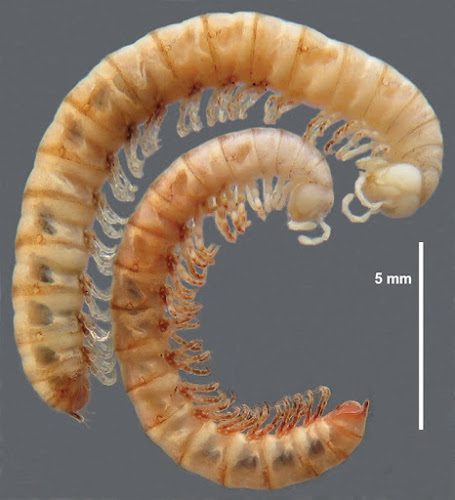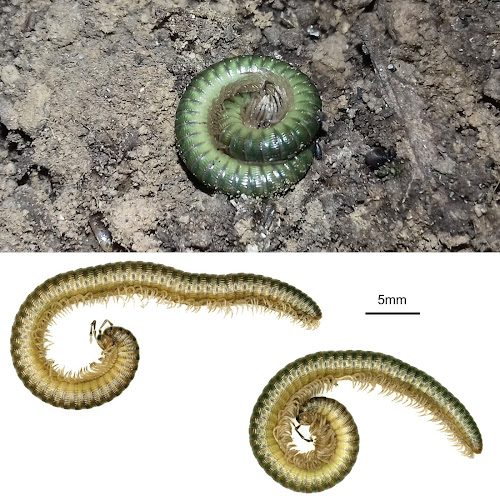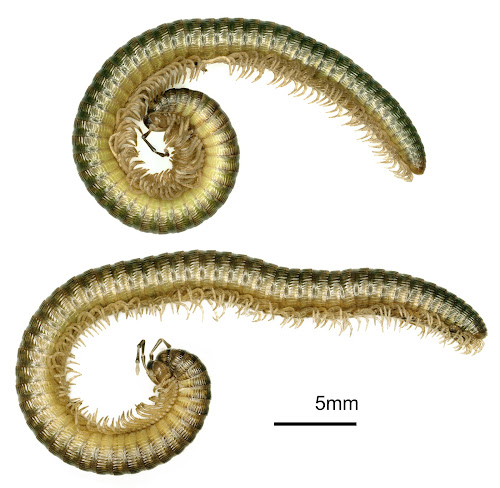[Most Recent Entries] [Calendar View]
Thursday, September 10th, 2020
| Time | Event | ||||||
| 10:54a | [Diplopoda • 2020] Kebodesmus zonarius • A New Genus and Species of Narrow-range Millipede (Polydesmida, Dalodesmidae) from Tasmania, Australia
Abstract Kebodesmus zonarius gen. nov. et sp. nov. is only known from a small area on the Great Western Tiers in northern Tasmania, Australia, and like species of Paredrodesmus Mesibov, 2003 has no detectable paranota on the diplosegments. The gonopod telopodite of the new species is divided into a large, lateral, cowl-like structure, a solenomere and a medial branch with three processes. Keywords: Australia, Dalodesmidae, Diplopoda, Polydesmida, Tasmania Order Polydesmida Pocock, 1887 Suborder Dalodesmidea Hoffman, 1980 Family Dalodesmidae Cook, 1896 Kebodesmus Mesibov & Rodriguez, gen. nov. Type species: Kebodesmus zonarius sp. nov., by present designation. Diagnosis: Closely similar in general appearance to species of Paredrodesmus Mesibov, 2003, but distinguished from Paredrodesmus species in having H+20 body plan rather than H+19; normal pore formula rather than 5, 7–18; sphaerotrichomes on legs rather than no sphaerotrichomes; dorsal spinnerets within depression below epiproct tip rather than on epiproct rim; and a phenolic defensive secretion rather than no odour detectable from living specimens. Distinguished from all other Tasmanian Dalodesmidea (apart from Paredrodesmus) by the complete absence of paranota or traces of paranota on the diplosegments, and by the deep division of the gonopod telopodite. Name: In honour of Kevin Bonham (Ke – bo), Tasmanian naturalist, collector and identifier, who emailed the senior author in May 2020 to say he had collected a millipede “whose gonopods I couldn’t even remotely match to anything”. Remarks: In gonopod structure Kebodesmus gen. nov. is unlike any of the undescribed Dalodesmidae so far examined in mainland Australian collections, and unlike any of the New Zealand Dalodesmidae described by Johns (1964, 1970). The gonopod in the new species is similar to that of Abatodesmus velosoi Demange & Silva, 1971, a H+20 dalodesmid from the Cordillera de Nahuelbuta in southern Chile, but differs in having the solenomere base clearly separated from the other telopodite processes. Kebodesmus zonarius Mesibov & Rodriguez, sp. nov. Name: Latin zonarius, zonal, adjective. This species appears to be restricted to a narrow altitudinal zone on Tasmania’s Great Western Tiers. Distribution and ecology: So far known from four sites in wet eucalypt forest at ca 800 m a.s.l. on the Great Western Tiers in northern Tasmania, south of the town of Deloraine, with a linear range extent of less than 1 km (Fig. 1B). Adults and juveniles are found in patches of richly organic soil and humus in the forest, which is dominated by Eucalyptus delegatensis subsp. tasmaniensis Boland. The new species co-occurs in humus with the native dalodesmids Lissodesmus alisonae Jeekel, 1984 and L. perporosus Jeekel, 1984, but was found in greater numbers than the other two species during searches in 2020. Robert Mesibov and Juanita Rodriguez. 2020. A New Genus and Species of Narrow-range Millipede (Diplopoda, Polydesmida, Dalodesmidae) from Tasmania, Australia. ZooKeys. 966: 1-8. DOI: 10.3897/zookeys.966.56308 | ||||||
| 11:14a | [Diplopoda • 2020] Lusitanipus xanin • A New Green-coloured Lusitanipus Mauriès, 1978 (Callipodida: Dorypetalidae) from the Iberian Peninsula
Abstract Recent samplings in cavities of the Iberian Peninsula led to the discovery of a new millipede species of the order Callipodida in one cave in the region of El Bierzo (León, Spain): Lusitanipus xanin sp. nov. In additional samplings (near that cave), more specimens of this new species were discovered in surface habitats. The species has various distinctive characteristics, such as its green colour, but the morphology of the gonopod has several similarities with that of Lusitanipus alternans (Verhoeff, 1893), indicating a close relationship between them. The diagnosis of the genus Lusitanipus Mauriès, 1978 has to be changed to accommodate the new species. The presence of crests in two different sizes is no longer a diagnostic character of the genus Lusitanipus, but of the species L. alternans. Lusitanipus xanin sp. nov. is the fourth species of the order Callipodida for the Iberian Peninsula, and the second species for the genus. Lusitanipus xanin sp. nov. seems to be an epigean but troglophile species. Keywords: El Bierzo; Myriapoda; new species; troglophile; Xanín
Order Callipodida Pocock, 1894 Family Dorypetalidae Verhoeff, 1900 Genus Lusitanipus Mauriès, 1978 Diagnosis as given in Reboleira & Enghoff (2015), but a change needs to be made to accommodate the new species. The presence of setiferous metazonital crests of two sizes (primary crests and secondary crests) is no longer a diagnostic character of the genus Lusitanipus but only of the species Lusitanipus alternans. Therefore, Lusitanipus differs from Cyphocallipus Verhoeff, 1909 by the simple gonocoxite and straight rodlike gonopodal pseudoflagellum, and from Dorycallipus Verhoeff, 1909 by males not having the forehead flattened. Lusitanipus xanin Gilgado sp. nov. Diagnosis Lusitanipus xanin sp. nov. differs from the other Iberian callipodidan species in the same characters as Lusitanipus alternans (see Reboleira & Enghoff 2015), except that Lusitanipus xanin sp. nov., has metazonital crests of similar size, whereas Lusitanipus alternans has crests of different sizes (Verhoeff 1893; Spelda 2015; Reboleira & Enghoff 2015). Furthermore, Lusitanipus xanin sp. nov. differs from L. alternans in its green colour, the higher number of body rings, the shape of the gonocoxite, and the curvature and shape of the processes of the tip of telopodites of gonopods. Etymology The specific epithet xanin (noun in apposition) is the name of a goblin-like mythological creature, the “Xanín”. This being supposedly inhabits the forests of the region were this species was found (El Bierzo). As the “Xanín”, this species is a small creature dwelling on the ground under the shade of the foliage that is seldomly seen and tries to hide when discovered. José Domingo Gilgado, Virginia Martínez-Pillado and Carlos E. Prieto. 2020. A New Green-coloured Lusitanipus Mauriès, 1978 from the Iberian Peninsula (Diplopoda: Callipodida: Dorypetalidae). European Journal of Taxonomy. 714: 1–14. DOI: 10.5852/ejt.2020.714 | ||||||
| 12:36p | [Botany • 2020] A Revision of the florbella group of Miconia (Melastomataceae, Miconieae) with Description of Three New Species: Miconia cava, M. florbella & M. valenzuelana
Abstract The florbella group of Miconia is composed of four species from the central Andes that are characterized by hollow stems inhabited by ants, and pleiostemonous flowers with a calyptrate calyx. The four species are M. inusitata, and the newly described here M. cava, M. florbella, and M. valenzuelana. The combination of pleistemonous flowers and calyptrate calyces suggests that these species could be placed in the former Conostegia, but at least three of the four species discussed here (M. florbella, M. inusitata and M. valenzuelana) do not belong in that clade and are more closely related to other species of Andean Miconia. All four species grow in undisturbed areas in low- to middle-elevation forests in the Andes. Keywords: Calyptrate calyx, Conostegia, Florbella, Ecuador, mymercophyly, Peru, pleiostemony Miconia cava Michelang. & R. Goldenb., sp. nov. Etymology.—The specific epithet refers to the hollow nature of the young terminal branches. Miconia florbella Schnell ex Michelang. & R.Goldenb., sp. nov. Etymology.—The specific epithet is taken from the generic name that Schnell (1996) planned to give this species in his unpublished thesis. Florbella is a combination of the Spanish words for flower (flor) and beautiful (bella). Miconia valenzuelana Michelang. & R. Goldenb., sp. nov. Etymology.—This species is dedicated to Peruvian Botanist Luis Valenzuela Gamarra, whose plant collections, including one of the paratypes of this species, have greatly augmented knowledge of the flora of Peru. Fabián A. Michelangeli and Renato Goldenberg. 2020. A Revision of the florbella group of Miconia (Melastomataceae, Miconieae) with Description of Three New Species. Brittonia. DOI: 10.1007/s12228-020-09633-w |
| << Previous Day |
2020/09/10 [Calendar] |
Next Day >> |








